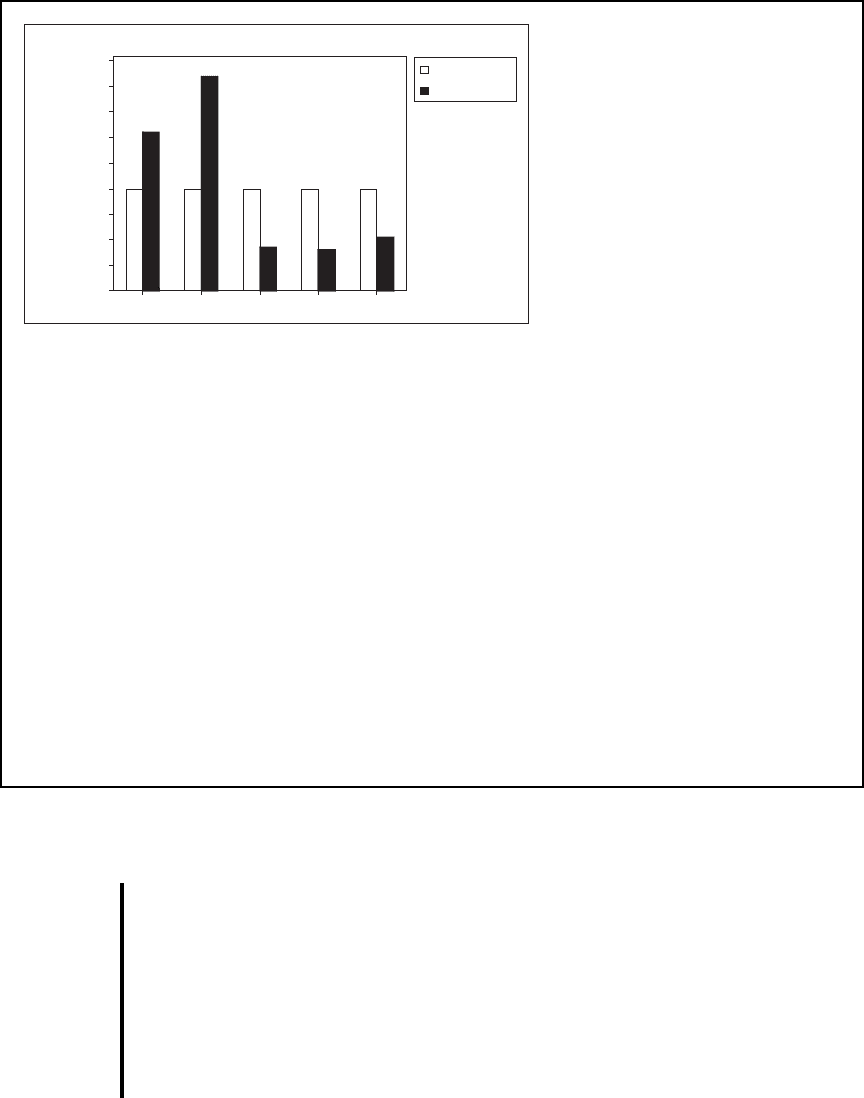Daniel W.W. Biostatistics: A Foundation for Analysis in the Health Sciences
Подождите немного. Документ загружается.


EXAMPLE 12.3.4
The Uniform Distribution
The flu season in southern Nevada for 2005–2006 ran from December to April, the
coldest months of the year. The Southern Nevada Health District reported the numbers
of vaccine-preventable influenza cases shown in Table 12.3.9. We are interested in
knowing whether the numbers of flu cases in the district are equally distributed among
the five flu season months. That is, we wish to know if flu cases follow a uniform
distribution.
Solution:
1. Data. See Table 12.3.9.
2. Assumptions. We assume that the reported cases of flu constitute a sim-
ple random sample of cases of flu that occurred in the district.
3. Hypotheses.
Flu cases in southern Nevada are uniformly distributed over the five
flu season months.
Flu cases in southern Nevada are not uniformly distributed over the
five flu season months.
Let
4. Test statistic. The test statistic is
5. Distribution of test statistic. If is true, X
2
is distributed approxi-
mately as with degrees of freedom.
6. Decision rule. Reject if the computed value of X
2
is equal to or
greater than 13.277.
H
0
15 - 12= 4x
2
H
0
X
2
=
a
1O
i
- E
i
2
2
E
i
a = .01.
H
A
:
H
0
:
12.3 TESTS OF GOODNESS-OF-FIT 607
TABLE 12.3.9 Reported Vaccine-Preventable
Influenza Cases from Southern Nevada,
December 2005–April 2006
Number of
Reported Cases
Month of Influenza
December 2005 62
January 2006 84
February 2006 17
March 2006 16
April 2006 21
Total 200
Source: http://www.southernnevadahealthdistrict.org/
epidemiology/disease_statistics.htm.

7. Calculation of test statistic. If the null hypothesis is true, we would
expect to observe 200 5 40 cases per month. Figure 12.3.2 shows the
computer printout obtained from MINITAB. The bar graph shows the
observed and expected frequencies per month. The chi-square table pro-
vides the observed frequencies, the expected frequencies based on a uni-
form distribution, and the individual chi-square contribution for each test
value.
8. Statistical decision. Since 97.15, the computed value of X
2
, is greater
than 13.277, we reject, based on these data, the null hypothesis of a
>
608 CHAPTER 12 THE CHI-SQUARE DISTRIBUTION AND THE ANALYSIS OF FREQUENCIES
FIGURE 12.3.2 MINITAB output for Example 12.3.4.
Chi-Square Goodness-of-Fit Test for Observed Counts in Variable: C1
Test Contribution
Category Observed Proportion Expected to Chi-Sq
1 62 0.2 40 12.100
2 84 0.2 40 48.400
3 17 0.2 40 13.225
4 16 0.2 40 14.400
5 21 0.2 40 9.025
N DF Chi-Sq P-Value
200 4 97.15 0.000
Category
54321
90
80
70
60
50
40
30
20
10
0
Value
Expected
Observed
Chart of Observed and Expected Values

uniform distribution of flu cases during the flu season in southern
Nevada.
9. Conclusion. We conclude that the occurrence of flu cases does not fol-
low a uniform distribution.
10. p value. From the MINITAB output we see that p .000 (i.e., .001).
■
EXAMPLE 12.3.5
A certain human trait is thought to be inherited according to the ratio 1:2:1 for
homozygous dominant, heterozygous, and homozygous recessive. An examination of
a simple random sample of 200 individuals yielded the following distribution of the
trait: dominant, 43; heterozygous, 125; and recessive, 32. We wish to know if these
data provide sufficient evidence to cast doubt on the belief about the distribution of
the trait.
Solution:
1. Data. See statement of the example.
2. Assumptions. We assume that the data meet the requirements for the ap-
plication of the chi-square goodness-of-fit test.
3. Hypotheses.
: The trait is distributed according to the ratio 1:2:1 for homozygous
dominant, heterozygous, and homozygous recessive.
: The trait is not distributed according to the ratio 1:2:1.
4. Test statistic. The test statistic is
5. Distribution of test statistic. If is true, is distributed as chi-square
with 2 degrees of freedom.
6. Decision rule. Suppose we let the probability of committing a type I error
be .05. Reject if the computed value of is equal to or greater than
5.991.
7. Calculation of test statistic. If is true, the expected frequencies for
the three manifestations of the trait are 50, 100, and 50 for dominant,
heterozygous, and recessive, respectively. Consequently,
8. Statistical decision. Since , we reject
9. Conclusion. We conclude that the trait is not distributed according to the
ratio 1:2:1.
10. p value. Since the p value for the test is
■
p 6 .005.13.71 7 10.597,
H
0
.13.71 7 5.991
X
2
= 143 - 502
2
>50 + 1125 - 10022>100 + 132 - 502
2
>50 = 13.71
H
0
X
2
H
0
X
2
H
0
X
2
=
a
c
1O - E2
2
E
d
H
A
H
0
12.3 TESTS OF GOODNESS-OF-FIT
609

EXERCISES
12.3.1 The following table shows the distribution of uric acid determinations taken on 250 patients. Test
the goodness-of-fit of these data to a normal distribution with and Let
Uric Acid Observed Uric Acid Observed
Determination Frequency Determination Frequency
1 6 to 6.99 45
1 to 1.99 5 7 to 7.99 30
2 to 2.99 15 8 to 8.99 22
3 to 3.99 24 9 to 9.99 10
4 to 4.99 43 10 or higher 5
5 to 5.99 50
Total 250
12.3.2 The following data were collected on 300 eight-year-old girls. Test, at the .05 level of significance,
the null hypothesis that the data are drawn from a normally distributed population. The sample
mean and standard deviation computed from grouped data are 127.02 and 5.08.
Height in Observed Height in Observed
Centimeters Frequency Centimeters Frequency
114 to 115.9 5 128 to 129.9 43
116 to 117.9 10 130 to 131.9 42
118 to 119.9 14 132 to 133.9 30
120 to 121.9 21 134 to 135.9 11
122 to 123.9 30 136 to 137.9 5
124 to 125.9 40 138 to 139.9 4
126 to 127.9 45
Total 300
12.3.3 The face sheet of patients’ records maintained in a local health department contains 10 entries.
A sample of 100 records revealed the following distribution of erroneous entries:
Number of Erroneous
Entries Out of 10 Number of Records
08
125
232
324
410
5 or more 1
Total 100
6 1
a = .01.s = 2.01.m = 5.74
610 CHAPTER 12 THE CHI-SQUARE DISTRIBUTION AND THE ANALYSIS OF FREQUENCIES

Test the goodness-of-fit of these data to the binomial distribution with Find the p value
for this test.
12.3.4 In a study conducted by Byers et al. (A-2), researchers tested a Poisson model for the distribution
of activities of daily living (ADL) scores after a 7-month prehabilitation program designed to pre-
vent functional decline among physically frail, community-living older persons. ADL measured
the ability of individuals to perform essential tasks, including walking inside the house, bathing,
upper and lower body dressing, transferring from a chair, toileting, feeding, and grooming. The
scoring method used in this study assigned a value of 0 for no (personal) help and no difficulty,
1 for difficulty but no help, and 2 for help regardless of difficulty. Scores were summed to pro-
duce an overall score ranging from 0 to 16 (for eight tasks). There were 181 subjects who com-
pleted the study. Suppose we use the authors’ scoring method to assess the status of another group
of 181 subjects relative to their activities of daily living. Let us assume that the following results
were obtained.
Observed Expected Observed Expected
X Frequency X Frequency X Frequency X Frequency
0 74 11.01 7 4 2.95
1 27 30.82 8 3 1.03
2 14 43.15 9 2 0.32
3 14 40.27 10 3 0.09
4 11 28.19 11 4 0.02
5 7 15.79 12 or more 13 0.01
6 5 7.37
Source: Hypothetical data based on procedure reported by Amy L. Byers, Heather Allore,
Thomas M. Gill, and Peter N. Peduzzi, “Application of Negative Binomial Modeling for
Discrete Outcomes: A Case Study in Aging Research,” Journal of Clinical Epidemiology, 56
(2003), 559–564.
Test the null hypothesis that these data were drawn from a Poisson distribution with Let
12.3.5 The following are the numbers of a particular organism found in 100 samples of water from a
pond:
Number of Organisms Number of Organisms
per Sample Frequency per Sample Frequency
01545
13054
22561
32070
Total 100
Test the null hypothesis that these data were drawn from a Poisson distribution. Determine the p
value for this test.
a = .01.
l = 2.8.
p = .20.
EXERCISES 611

12.3.6 A research team conducted a survey in which the subjects were adult smokers. Each subject in a
sample of 200 was asked to indicate the extent to which he or she agreed with the statement: “I
would like to quit smoking.” The results were as follows:
Response: Strongly agree Agree Disagree Strongly Disagree
Number
Responding: 102 30 60 8
Can one conclude on the basis of these data that, in the sampled population, opinions are not
equally distributed over the four levels of agreement? Let the probability of committing a type I
error be .05 and find the p value.
12.4 TESTS OF INDEPENDENCE
Another, and perhaps the most frequent, use of the chi-square distribution is to test the
null hypothesis that two criteria of classification, when applied to the same set of enti-
ties, are independent. We say that two criteria of classification are independent if the
distribution of one criterion is the same no matter what the distribution of the other cri-
terion. For example, if socioeconomic status and area of residence of the inhabitants of
a certain city are independent, we would expect to find the same proportion of families
in the low, medium, and high socioeconomic groups in all areas of the city.
The Contingency Table The classification, according to two criteria, of a set
of entities, say, people, can be shown by a table in which the r rows represent the var-
ious levels of one criterion of classification and the c columns represent the various
levels of the second criterion. Such a table is generally called a contingency table. The
classification according to two criteria of a finite population of entities is shown in
Table 12.4.1.
We will be interested in testing the null hypothesis that in the population the two
criteria of classification are independent. If the hypothesis is rejected, we will conclude
612
CHAPTER 12 THE CHI-SQUARE DISTRIBUTION AND THE ANALYSIS OF FREQUENCIES
TABLE 12.4.1 Two-Way Classification of a Finite
Population of Entities
Second
Criterion of
First Criterion of Classification Level
Classification
Level 1 2 3
...
c
Total
1
2
3
r
Total NN
.
c
...
N
.
3
N
.
2
N
.
1
N
r
.
N
rc
...
N
r3
N
r2
N
r1
ooooooo
N
3
.
N
3c
...
N
33
N
32
N
31
N
2
.
N
2c
...
N
23
N
22
N
21
N
1
.
N
1c
...
N
13
N
12
N
11

that the two criteria of classification are not independent. A sample of size n will be drawn
from the population of entities, and the frequency of occurrence of entities in the sample
corresponding to the cells formed by the intersections of the rows and columns of Table
12.4.1 along with the marginal totals will be displayed in a table such as Table 12.4.2.
Calculating the Expected Frequencies The expected frequency, under
the null hypothesis that the two criteria of classification are independent, is calculated
for each cell.
We learned in Chapter 3 (see Equation 3.4.4) that if two events are independent,
the probability of their joint occurrence is equal to the product of their individual prob-
abilities. Under the assumption of independence, for example, we compute the probabil-
ity that one of the n subjects represented in Table 12.4.2 will be counted in Row 1 and
Column 1 of the table (that is, in Cell 11) by multiplying the probability that the sub-
ject will be counted in Row 1 by the probability that the subject will be counted in Col-
umn 1. In the notation of the table, the desired calculation is
To obtain the expected frequency for Cell 11, we multiply this probability by the total
number of subjects, n. That is, the expected frequency for Cell 11 is given by
Since the n in one of the denominators cancels into numerator n, this expression reduces to
In general, then, we see that to obtain the expected frequency for a given cell, we mul-
tiply the total of the row in which the cell is located by the total of the column in which
the cell is located and divide the product by the grand total.
1n
1
.
21n
.
1
2
n
a
n
1
.
n
ba
n
.
1
n
b1n2
a
n
1
.
n
ba
n
.
1
n
b
12.4 TESTS OF INDEPENDENCE 613
TABLE 12.4.2 Two-Way Classification of a Sample
of Entities
Second
Criterion of
First Criterion of Classification Level
Classification
Level 1 2 3
...
c
Total
1
2
3
r
Total nn
.
c
...
n
.
3
n
.
2
n
.
1
n
r
.
n
rc
...
n
r 3
n
r 2
n
r1
oooooo
n
3
.
n
3c
...
n
33
n
32
n
31
n
2
.
n
2c
...
n
23
n
22
n
21
n
1
.
n
1c
...
n
13
n
12
n
11

Observed Versus Expected Frequencies The expected frequencies and
observed frequencies are compared. If the discrepancy is sufficiently small, the null hypoth-
esis is tenable. If the discrepancy is sufficiently large, the null hypothesis is rejected, and
we conclude that the two criteria of classification are not independent. The decision as to
whether the discrepancy between observed and expected frequencies is sufficiently large
to cause rejection of will be made on the basis of the size of the quantity computed
when we use Equation 12.2.4, where and refer, respectively, to the observed and
expected frequencies in the cells of Table 12.4.2. It would be more logical to designate the
observed and expected frequencies in these cells by and but to keep the notation
simple and to avoid the introduction of another formula, we have elected to use the sim-
pler notation. It will be helpful to think of the cells as being numbered from 1 to k, where
1 refers to Cell 11 and k refers to Cell rc. It can be shown that as defined in this man-
ner is distributed approximately as with degrees of freedom when the
null hypothesis is true. If the computed value of is equal to or larger than the tabulated
value of for some the null hypothesis is rejected at the level of significance. The
hypothesis testing procedure is illustrated with the following example.
EXAMPLE 12.4.1
In 1992, the U.S. Public Health Service and the Centers for Disease Control and Pre-
vention recommended that all women of childbearing age consume 400 mg of folic acid
daily to reduce the risk of having a pregnancy that is affected by a neural tube defect
such as spina bifida or anencephaly. In a study by Stepanuk et al. (A-3), 693 pregnant
women called a teratology information service about their use of folic acid supplemen-
tation. The researchers wished to determine if preconceptional use of folic acid and race
are independent. The data appear in Table 12.4.3.
Solution:
1. Data. See Table 12.4.3.
2. Assumptions. We assume that the sample available for analysis is equiv-
alent to a simple random sample drawn from the population of interest.
aa,x
2
X
2
1r - 121c - 12x
2
X
2
E
ij
,O
ij
E
i
O
i
H
0
614 CHAPTER 12 THE CHI-SQUARE DISTRIBUTION AND THE ANALYSIS OF FREQUENCIES
TABLE 12.4.3 Race of Pregnant Caller and Use of
Folic Acid
Preconceptional Use of Folic Acid
Yes No Total
White 260 299 559
Black 15 41 56
Other 7 14 21
Total 282 354 636
Source: Kathleen M. Stepanuk, Jorge E. Tolosa, Dawneete Lewis,
Victoria Meyers, Cynthia Royds, Juan Carlos Saogal, and Ron Librizzi,
“Folic Acid Supplementation Use Among Women Who Contact a Teratol-
ogy Information Service,”
American Journal of Obstetrics and Gynecol-
ogy, 187
(2002), 964–967.

3. Hypotheses.
Race and preconceptional use of folic acid are independent.
The two variables are not independent.
Let .
4. Test statistic. The test statistic is
5. Distribution of test statistic. When is true, is distributed ap-
proximately as with
2 degrees of freedom.
6. Decision rule. Reject if the computed value of is equal to or
greater than 5.991.
7. Calculation of test statistic. The expected frequency for the first cell is
. The other expected frequencies are calcu-
lated in a similar manner. Observed and expected frequencies are dis-
played in Table 12.4.4. From the observed and expected frequencies we
may compute
8. Statistical decision. We reject since
9. Conclusion. We conclude that is false, and that there is a relationship
between race and preconceptional use of folic acid.
10. p value. Since 7.378 6 9.08960 6 9.210, .01 6 p 6 .025.
H
0
9.08960 7 5.991.H
0
= .59461 + .47368 +
. . .
+ .45647 = 9.08960
=
1260 - 247.862
2
247.86
+
1299 - 311.142
2
311.14
+
. . .
+
114 - 11.692
2
11.69
X
2
=
a
c
1O
i
- E
i
2
2
E
i
d
1559 * 2822>636 = 247.86
X
2
H
0
1r - 121c - 12= 13 - 1212 - 12= 122112=x
2
X
2
H
0
X
2
=
a
k
i =1
c
1O
i
- E
i
2
2
E
i
d
a = .05
H
A
:
H
0
:
12.4 TESTS OF INDEPENDENCE 615
TABLE 12.4.4 Observed and Expected Frequencies
for Example 12.4.1
Preconceptional Use of Folic Acid
Yes No Total
White 260 (247.86) 299 (311.14) 559
Black 15 (24.83) 41 (31.17) 56
Other 7 (9.31) 14 (11.69) 21
Total 282 354 636
■

Computer Analysis The computer may be used to advantage in calculating
for tests of independence and tests of homogeneity. Figure 12.4.1 shows the procedure
and printout for Example 12.4.1 when the MINITAB program for computing from
contingency tables is used. The data were entered into MINITAB Columns 1 and 2, cor-
responding to the columns of Table 12.4.3.
We may use SAS
®
to obtain an analysis and printout of contingency table data by
using the PROC FREQ statement. Figure 12.4.2 shows a partial SAS
®
printout reflecting
the analysis of the data of Example 12.4.1.
X
2
X
2
616 CHAPTER 12 THE CHI-SQUARE DISTRIBUTION AND THE ANALYSIS OF FREQUENCIES
FIGURE 12.4.1 MINITAB procedure and output for chi-square analysis of data in Table 12.4.3.
Data:
C1: 260 15 7
C2: 299 41 14
Dialog Box: Session command:
Stat
➤ Tables ➤ Chi-square Test MTB > CHISQUARE C1-C3
Type C1-C2 in Columns containing the table.
Click OK.
Output:
Chi-Square Test: C1, C2
Expected counts are printed below observed counts
C1 C2 Total
1 260 299 559
247.86 311.14
2154156
24.83 31.17
3 7 14 21
9.31 11.69
Total 282 354 636
Chi-Sq = 0.595 + 0.474 +
3.892 + 3.100 +
0.574 + 0.457 = 9.091
DF = 2, P-Value = 0.011
